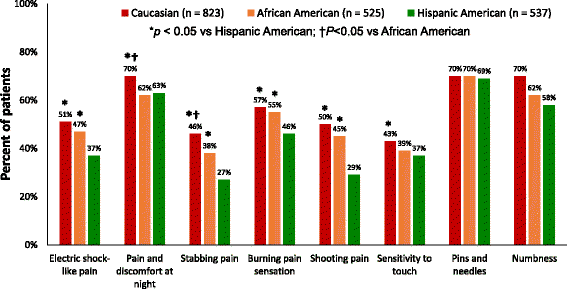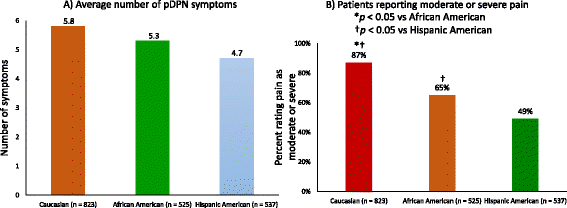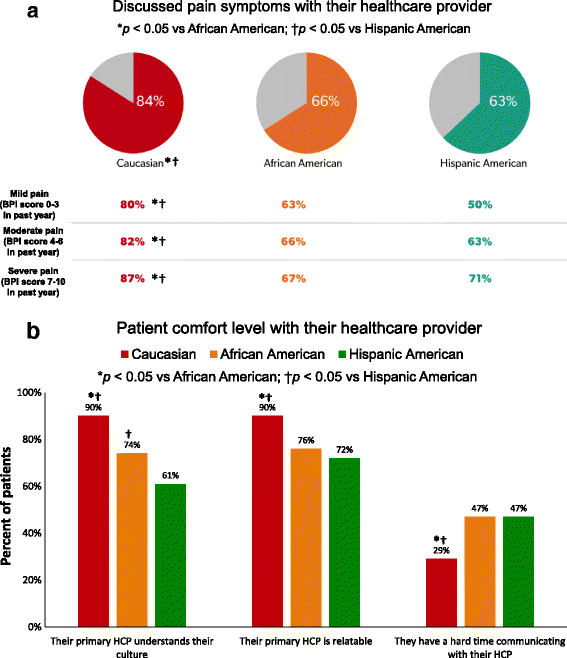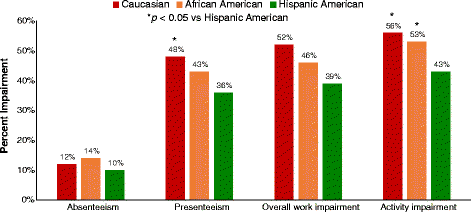Perspectives on the impact of painful diabetic peripheral neuropathy in a multicultural population
- PMID: 29299335
- PMCID: PMC5745600
- DOI: 10.1186/s40842-017-0051-2
Perspectives on the impact of painful diabetic peripheral neuropathy in a multicultural population
Abstract
Background: Since few studies have characterized painful diabetic peripheral neuropathy (pDPN) symptoms in multicultural populations, this study fielded a survey to better understand pDPN and its impact in African-American, Caucasian, and Hispanic populations.
Methods: Kelton fielded a survey by phone or Internet, in English or Spanish, among adults with pDPN symptoms in the United States between August and October 2015; African-Americans and Hispanics were oversampled to achieve at least 500 subjects for each group. Patients were required to have been diagnosed with pDPN or score ≥ 3 on ID Pain validated screening tool. The survey elicited information on pDPN symptoms and interactions with healthcare providers (HCPs), and included the Brief Pain Inventory and pain-specific Work Productivity and Assessment Questionnaire (WPAI:SHP).
Results: Respondents included 823 Caucasians, 525 African-Americans, and 537 Hispanics; approximately half of African-Americans and Hispanics were <40 years of age, vs 12% of Caucasians. Pain was less likely to be rated moderate or severe by African-Americans (65%) and Hispanics (49%) relative to Caucasians (87%; p < 0.05). African-Americans and Hispanics were less likely than Caucasians to report experiencing specific pDPN sensory symptoms. Significantly fewer African-Americans and Hispanics reported receiving a pDPN diagnosis relative to Caucasians (p < 0.05), and higher proportions of African-Americans and Hispanics reported difficulty communicating with their HCP (p < 0.05). WPAI:SHP activity impairment was lower in Hispanics (43%) relative to African-Americans (53%) and Caucasian (56%; p < 0.05).
Conclusions: Multicultural patients reported differences in pDPN symptoms and pain relative to Caucasians, and fewer received a pDPN diagnosis. While further evaluation is needed to understand these differences, these data suggest a need to broaden pDPN educational initiatives to improve patient-HCP dialogue and encourage discussion of pDPN symptoms and their impact in a multicultural setting.
Keywords: Ethnicity; Pain; Painful diabetic peripheral neuropathy; Productivity; Race.
Conflict of interest statement
Ethics/Institutional Review Board (IRB) approval was not obtained for this study, which was conducted by Kelton Global, a market research firm, who accessed existing participant panels across the US.; all subjects had previously agreed to participate in the national research panel that was accessed. Additionally, all subjects were advised, either verbally for phone participation, or via an initial online screen for Internet participation that “The results may appear in leading media outlets in the coming weeks, but your answers will remain confidential and anonymous.”Not applicableME is an employee of Kelton Global. AHA was an employee and shareholder of Pfizer at the time of the study and development of the manuscript. BP, JCC, PH, and AS are paid employees and shareholders of Pfizer. MMT is a practicing neurologist and reports no conflicts of interest.Springer Nature remains neutral with regard to jurisdictional claims in published maps and institutional affiliations.
Figures





References
-
- Jambart S, Ammache Z, Haddad F, Younes A, Hassoun A, Abdalla K, Selwan CA, Sunna N, Wajsbrot D, Youseif E. Prevalence of painful diabetic peripheral neuropathy among patients with diabetes mellitus in the Middle East region. J Int Med Res. 2011;39(2):366–377. doi: 10.1177/147323001103900204. - DOI - PubMed
LinkOut - more resources
Full Text Sources
Other Literature Sources
Miscellaneous

